An Evaluation of Funding Models for Higher Education in the UK
VerifiedAdded on 2021/04/21
|7
|1803
|56
Report
AI Summary
This report examines the evolution of tuition fees in the UK, introduced in 1988, and their impact on higher education funding. It analyzes three primary funding models: general taxation, graduate tax, and student loans. The report details the advantages and disadvantages of each approach, considering factors like fairness, international student contributions, and financial burdens on students. The analysis reveals that student loans offer the most beneficial approach, providing opportunities for students, particularly those in need, while minimizing financial strain on the broader population and offering a manageable repayment structure. The report also highlights the importance of low-interest rates and the absence of security requirements for student loans, making them an attractive option. The conclusion recommends student loans as the most effective and equitable funding mechanism for higher education in the UK, leading to a win-win situation for both lenders and borrowers.

FUNDING HIGHER EDUCATION
Paraphrase This Document
Need a fresh take? Get an instant paraphrase of this document with our AI Paraphraser
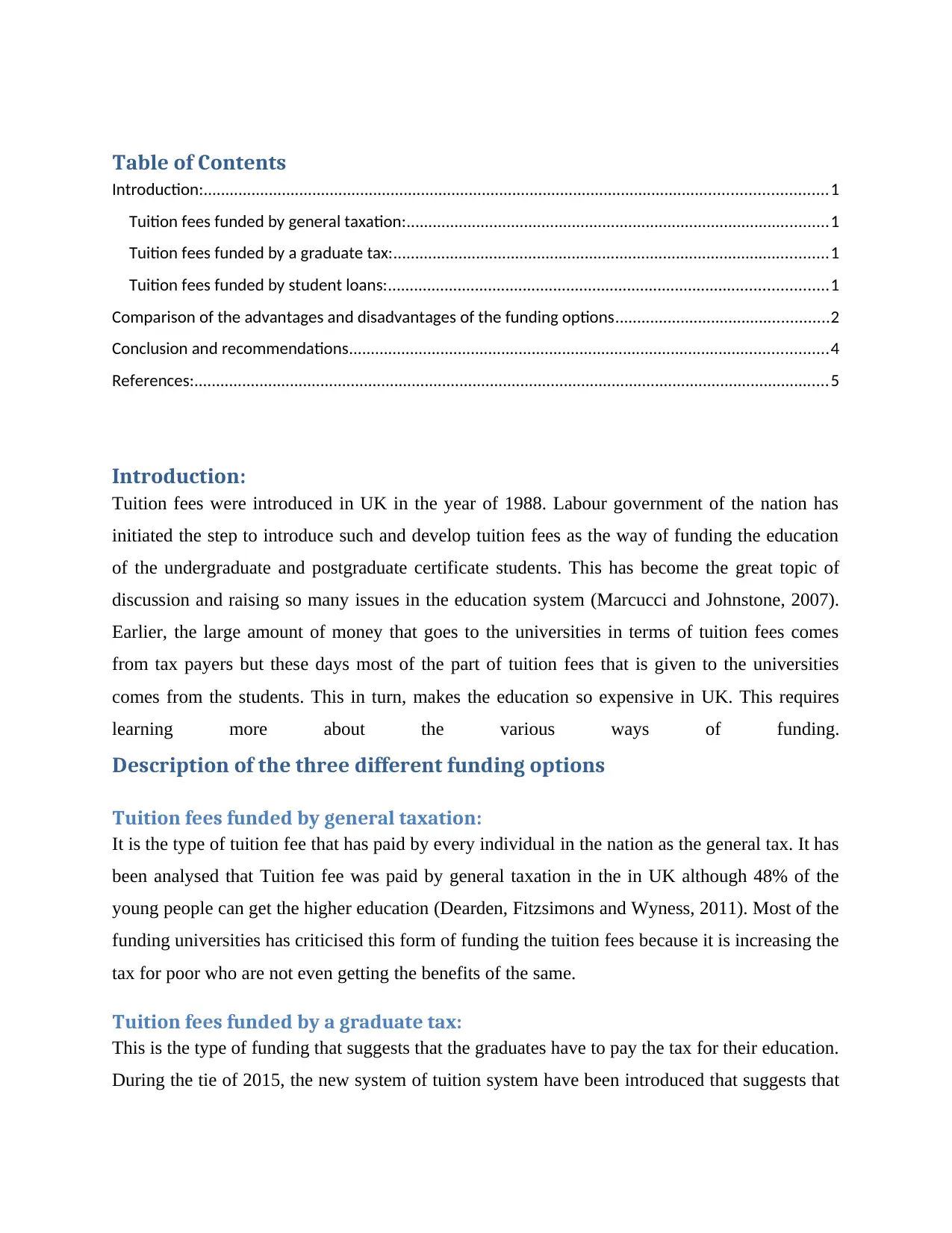
Table of Contents
Introduction:...............................................................................................................................................1
Tuition fees funded by general taxation:.................................................................................................1
Tuition fees funded by a graduate tax:....................................................................................................1
Tuition fees funded by student loans:.....................................................................................................1
Comparison of the advantages and disadvantages of the funding options.................................................2
Conclusion and recommendations..............................................................................................................4
References:..................................................................................................................................................5
Introduction:
Tuition fees were introduced in UK in the year of 1988. Labour government of the nation has
initiated the step to introduce such and develop tuition fees as the way of funding the education
of the undergraduate and postgraduate certificate students. This has become the great topic of
discussion and raising so many issues in the education system (Marcucci and Johnstone, 2007).
Earlier, the large amount of money that goes to the universities in terms of tuition fees comes
from tax payers but these days most of the part of tuition fees that is given to the universities
comes from the students. This in turn, makes the education so expensive in UK. This requires
learning more about the various ways of funding.
Description of the three different funding options
Tuition fees funded by general taxation:
It is the type of tuition fee that has paid by every individual in the nation as the general tax. It has
been analysed that Tuition fee was paid by general taxation in the in UK although 48% of the
young people can get the higher education (Dearden, Fitzsimons and Wyness, 2011). Most of the
funding universities has criticised this form of funding the tuition fees because it is increasing the
tax for poor who are not even getting the benefits of the same.
Tuition fees funded by a graduate tax:
This is the type of funding that suggests that the graduates have to pay the tax for their education.
During the tie of 2015, the new system of tuition system have been introduced that suggests that
Introduction:...............................................................................................................................................1
Tuition fees funded by general taxation:.................................................................................................1
Tuition fees funded by a graduate tax:....................................................................................................1
Tuition fees funded by student loans:.....................................................................................................1
Comparison of the advantages and disadvantages of the funding options.................................................2
Conclusion and recommendations..............................................................................................................4
References:..................................................................................................................................................5
Introduction:
Tuition fees were introduced in UK in the year of 1988. Labour government of the nation has
initiated the step to introduce such and develop tuition fees as the way of funding the education
of the undergraduate and postgraduate certificate students. This has become the great topic of
discussion and raising so many issues in the education system (Marcucci and Johnstone, 2007).
Earlier, the large amount of money that goes to the universities in terms of tuition fees comes
from tax payers but these days most of the part of tuition fees that is given to the universities
comes from the students. This in turn, makes the education so expensive in UK. This requires
learning more about the various ways of funding.
Description of the three different funding options
Tuition fees funded by general taxation:
It is the type of tuition fee that has paid by every individual in the nation as the general tax. It has
been analysed that Tuition fee was paid by general taxation in the in UK although 48% of the
young people can get the higher education (Dearden, Fitzsimons and Wyness, 2011). Most of the
funding universities has criticised this form of funding the tuition fees because it is increasing the
tax for poor who are not even getting the benefits of the same.
Tuition fees funded by a graduate tax:
This is the type of funding that suggests that the graduates have to pay the tax for their education.
During the tie of 2015, the new system of tuition system have been introduced that suggests that
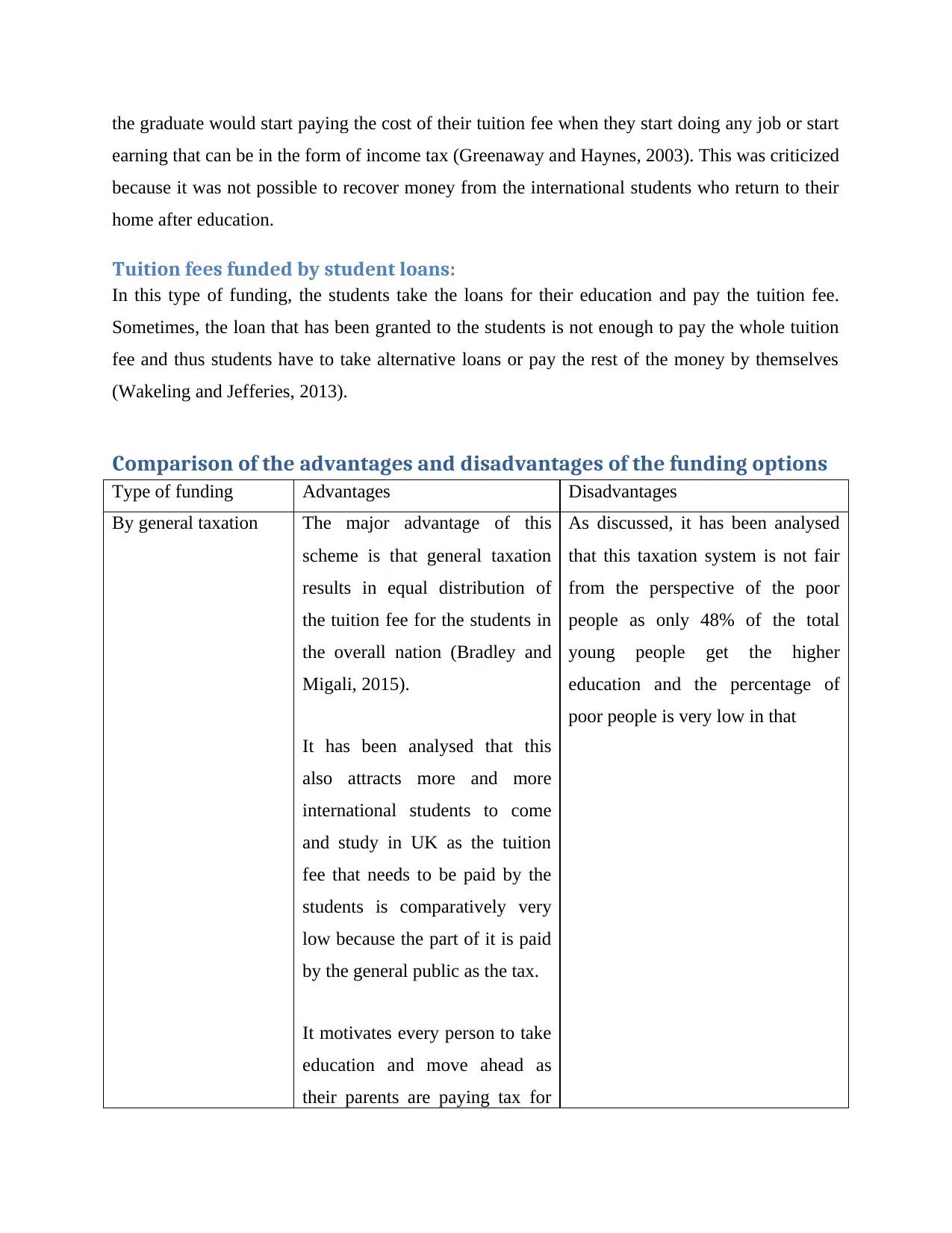
the graduate would start paying the cost of their tuition fee when they start doing any job or start
earning that can be in the form of income tax (Greenaway and Haynes, 2003). This was criticized
because it was not possible to recover money from the international students who return to their
home after education.
Tuition fees funded by student loans:
In this type of funding, the students take the loans for their education and pay the tuition fee.
Sometimes, the loan that has been granted to the students is not enough to pay the whole tuition
fee and thus students have to take alternative loans or pay the rest of the money by themselves
(Wakeling and Jefferies, 2013).
Comparison of the advantages and disadvantages of the funding options
Type of funding Advantages Disadvantages
By general taxation The major advantage of this
scheme is that general taxation
results in equal distribution of
the tuition fee for the students in
the overall nation (Bradley and
Migali, 2015).
It has been analysed that this
also attracts more and more
international students to come
and study in UK as the tuition
fee that needs to be paid by the
students is comparatively very
low because the part of it is paid
by the general public as the tax.
It motivates every person to take
education and move ahead as
their parents are paying tax for
As discussed, it has been analysed
that this taxation system is not fair
from the perspective of the poor
people as only 48% of the total
young people get the higher
education and the percentage of
poor people is very low in that
earning that can be in the form of income tax (Greenaway and Haynes, 2003). This was criticized
because it was not possible to recover money from the international students who return to their
home after education.
Tuition fees funded by student loans:
In this type of funding, the students take the loans for their education and pay the tuition fee.
Sometimes, the loan that has been granted to the students is not enough to pay the whole tuition
fee and thus students have to take alternative loans or pay the rest of the money by themselves
(Wakeling and Jefferies, 2013).
Comparison of the advantages and disadvantages of the funding options
Type of funding Advantages Disadvantages
By general taxation The major advantage of this
scheme is that general taxation
results in equal distribution of
the tuition fee for the students in
the overall nation (Bradley and
Migali, 2015).
It has been analysed that this
also attracts more and more
international students to come
and study in UK as the tuition
fee that needs to be paid by the
students is comparatively very
low because the part of it is paid
by the general public as the tax.
It motivates every person to take
education and move ahead as
their parents are paying tax for
As discussed, it has been analysed
that this taxation system is not fair
from the perspective of the poor
people as only 48% of the total
young people get the higher
education and the percentage of
poor people is very low in that
⊘ This is a preview!⊘
Do you want full access?
Subscribe today to unlock all pages.

Trusted by 1+ million students worldwide
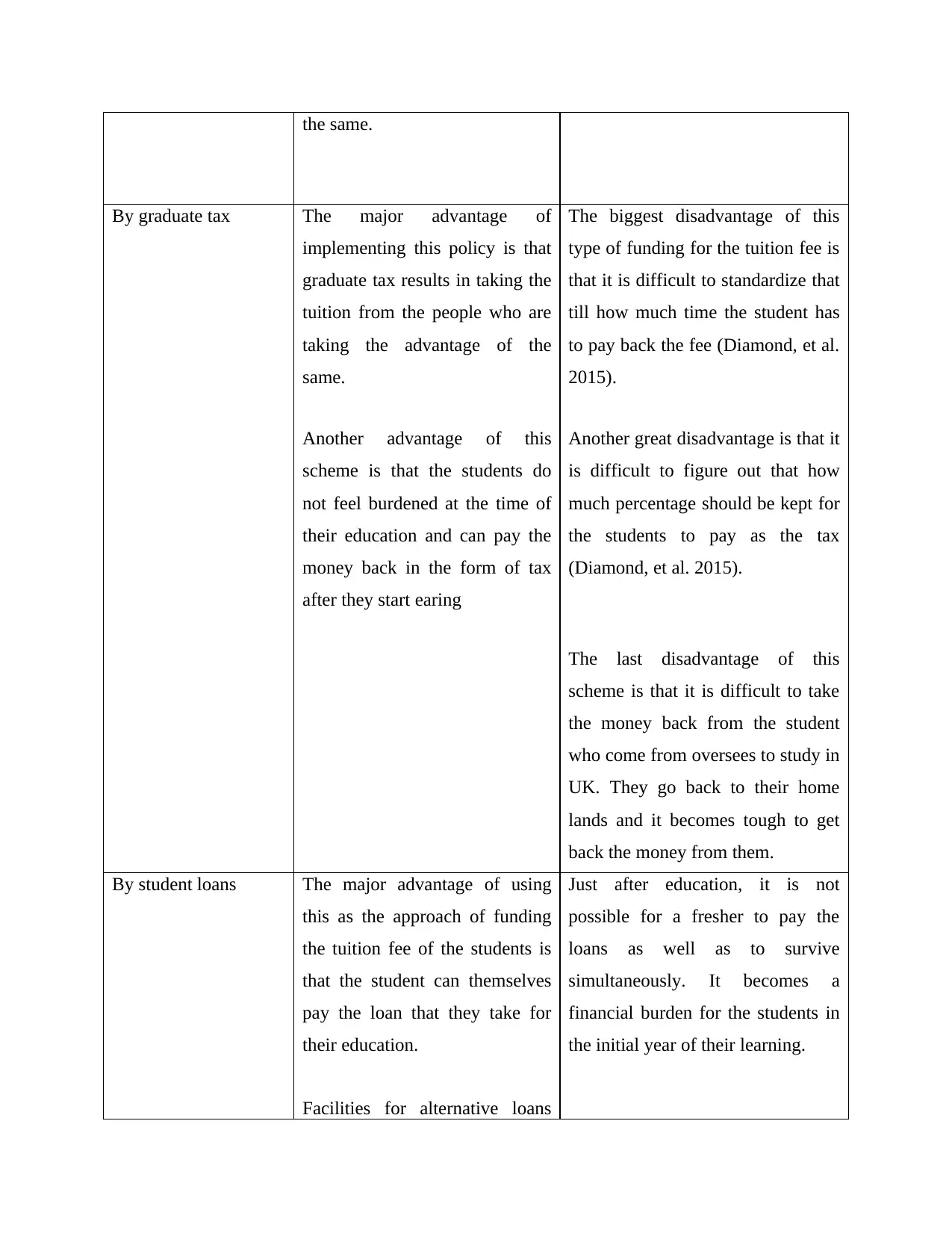
the same.
By graduate tax The major advantage of
implementing this policy is that
graduate tax results in taking the
tuition from the people who are
taking the advantage of the
same.
Another advantage of this
scheme is that the students do
not feel burdened at the time of
their education and can pay the
money back in the form of tax
after they start earing
The biggest disadvantage of this
type of funding for the tuition fee is
that it is difficult to standardize that
till how much time the student has
to pay back the fee (Diamond, et al.
2015).
Another great disadvantage is that it
is difficult to figure out that how
much percentage should be kept for
the students to pay as the tax
(Diamond, et al. 2015).
The last disadvantage of this
scheme is that it is difficult to take
the money back from the student
who come from oversees to study in
UK. They go back to their home
lands and it becomes tough to get
back the money from them.
By student loans The major advantage of using
this as the approach of funding
the tuition fee of the students is
that the student can themselves
pay the loan that they take for
their education.
Facilities for alternative loans
Just after education, it is not
possible for a fresher to pay the
loans as well as to survive
simultaneously. It becomes a
financial burden for the students in
the initial year of their learning.
By graduate tax The major advantage of
implementing this policy is that
graduate tax results in taking the
tuition from the people who are
taking the advantage of the
same.
Another advantage of this
scheme is that the students do
not feel burdened at the time of
their education and can pay the
money back in the form of tax
after they start earing
The biggest disadvantage of this
type of funding for the tuition fee is
that it is difficult to standardize that
till how much time the student has
to pay back the fee (Diamond, et al.
2015).
Another great disadvantage is that it
is difficult to figure out that how
much percentage should be kept for
the students to pay as the tax
(Diamond, et al. 2015).
The last disadvantage of this
scheme is that it is difficult to take
the money back from the student
who come from oversees to study in
UK. They go back to their home
lands and it becomes tough to get
back the money from them.
By student loans The major advantage of using
this as the approach of funding
the tuition fee of the students is
that the student can themselves
pay the loan that they take for
their education.
Facilities for alternative loans
Just after education, it is not
possible for a fresher to pay the
loans as well as to survive
simultaneously. It becomes a
financial burden for the students in
the initial year of their learning.
Paraphrase This Document
Need a fresh take? Get an instant paraphrase of this document with our AI Paraphraser

are also available for the
students to pay the tuition fee
(Middlehurst, 2016).
The students have the leverage
to pay back the loans in any of
the medium they want
Student loan recovery becomes a
tough job for the banks from the
students who may not get the
efficient jobs after their education
gets over.
Conclusion and recommendations
It has been concluded from the overall discussion that tuition fees were introduced in UK in the
year of 1988. This is the concept that has undergone many changes since year and become a
great issue of political debate. The cost of education in UK is rising day by day; this is because
of the instability of the funding of tuition fee for the undergraduate and postgraduate students in
UK.
There are three forms of funding for the tuition fee in UK. The first one is the general taxation,
the second one is the graduate tax and the third one is the student loan. It has been analysed that
most beneficial and the recommended form of funding should be student loans. This is because it
is the funding type that has the following advantages:
1. The biggest benefit of student loans is that it aids those needful students to fund their
education. It gives the opportunity to the intelligent student who can’t manage to fund
their tuition fee. This funding results in providing higher education and good jobs to the
students who deserves the same (Hughes, 2016). The student loans are designed in the
way such that it needs not to be paid immediately but the students can pay the loans in
instalments as per their convenience.
students to pay the tuition fee
(Middlehurst, 2016).
The students have the leverage
to pay back the loans in any of
the medium they want
Student loan recovery becomes a
tough job for the banks from the
students who may not get the
efficient jobs after their education
gets over.
Conclusion and recommendations
It has been concluded from the overall discussion that tuition fees were introduced in UK in the
year of 1988. This is the concept that has undergone many changes since year and become a
great issue of political debate. The cost of education in UK is rising day by day; this is because
of the instability of the funding of tuition fee for the undergraduate and postgraduate students in
UK.
There are three forms of funding for the tuition fee in UK. The first one is the general taxation,
the second one is the graduate tax and the third one is the student loan. It has been analysed that
most beneficial and the recommended form of funding should be student loans. This is because it
is the funding type that has the following advantages:
1. The biggest benefit of student loans is that it aids those needful students to fund their
education. It gives the opportunity to the intelligent student who can’t manage to fund
their tuition fee. This funding results in providing higher education and good jobs to the
students who deserves the same (Hughes, 2016). The student loans are designed in the
way such that it needs not to be paid immediately but the students can pay the loans in
instalments as per their convenience.
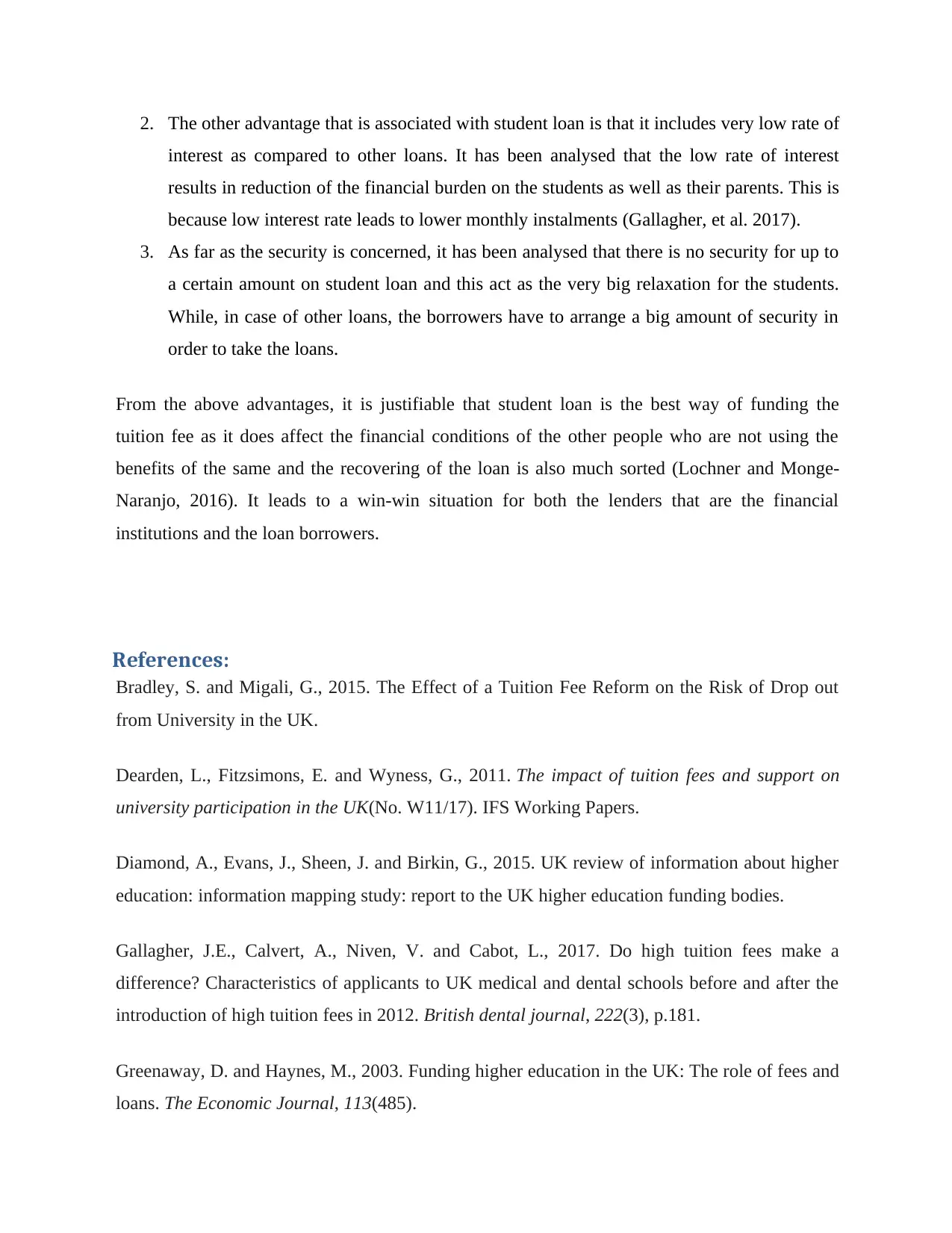
2. The other advantage that is associated with student loan is that it includes very low rate of
interest as compared to other loans. It has been analysed that the low rate of interest
results in reduction of the financial burden on the students as well as their parents. This is
because low interest rate leads to lower monthly instalments (Gallagher, et al. 2017).
3. As far as the security is concerned, it has been analysed that there is no security for up to
a certain amount on student loan and this act as the very big relaxation for the students.
While, in case of other loans, the borrowers have to arrange a big amount of security in
order to take the loans.
From the above advantages, it is justifiable that student loan is the best way of funding the
tuition fee as it does affect the financial conditions of the other people who are not using the
benefits of the same and the recovering of the loan is also much sorted (Lochner and Monge-
Naranjo, 2016). It leads to a win-win situation for both the lenders that are the financial
institutions and the loan borrowers.
References:
Bradley, S. and Migali, G., 2015. The Effect of a Tuition Fee Reform on the Risk of Drop out
from University in the UK.
Dearden, L., Fitzsimons, E. and Wyness, G., 2011. The impact of tuition fees and support on
university participation in the UK(No. W11/17). IFS Working Papers.
Diamond, A., Evans, J., Sheen, J. and Birkin, G., 2015. UK review of information about higher
education: information mapping study: report to the UK higher education funding bodies.
Gallagher, J.E., Calvert, A., Niven, V. and Cabot, L., 2017. Do high tuition fees make a
difference? Characteristics of applicants to UK medical and dental schools before and after the
introduction of high tuition fees in 2012. British dental journal, 222(3), p.181.
Greenaway, D. and Haynes, M., 2003. Funding higher education in the UK: The role of fees and
loans. The Economic Journal, 113(485).
interest as compared to other loans. It has been analysed that the low rate of interest
results in reduction of the financial burden on the students as well as their parents. This is
because low interest rate leads to lower monthly instalments (Gallagher, et al. 2017).
3. As far as the security is concerned, it has been analysed that there is no security for up to
a certain amount on student loan and this act as the very big relaxation for the students.
While, in case of other loans, the borrowers have to arrange a big amount of security in
order to take the loans.
From the above advantages, it is justifiable that student loan is the best way of funding the
tuition fee as it does affect the financial conditions of the other people who are not using the
benefits of the same and the recovering of the loan is also much sorted (Lochner and Monge-
Naranjo, 2016). It leads to a win-win situation for both the lenders that are the financial
institutions and the loan borrowers.
References:
Bradley, S. and Migali, G., 2015. The Effect of a Tuition Fee Reform on the Risk of Drop out
from University in the UK.
Dearden, L., Fitzsimons, E. and Wyness, G., 2011. The impact of tuition fees and support on
university participation in the UK(No. W11/17). IFS Working Papers.
Diamond, A., Evans, J., Sheen, J. and Birkin, G., 2015. UK review of information about higher
education: information mapping study: report to the UK higher education funding bodies.
Gallagher, J.E., Calvert, A., Niven, V. and Cabot, L., 2017. Do high tuition fees make a
difference? Characteristics of applicants to UK medical and dental schools before and after the
introduction of high tuition fees in 2012. British dental journal, 222(3), p.181.
Greenaway, D. and Haynes, M., 2003. Funding higher education in the UK: The role of fees and
loans. The Economic Journal, 113(485).
⊘ This is a preview!⊘
Do you want full access?
Subscribe today to unlock all pages.

Trusted by 1+ million students worldwide
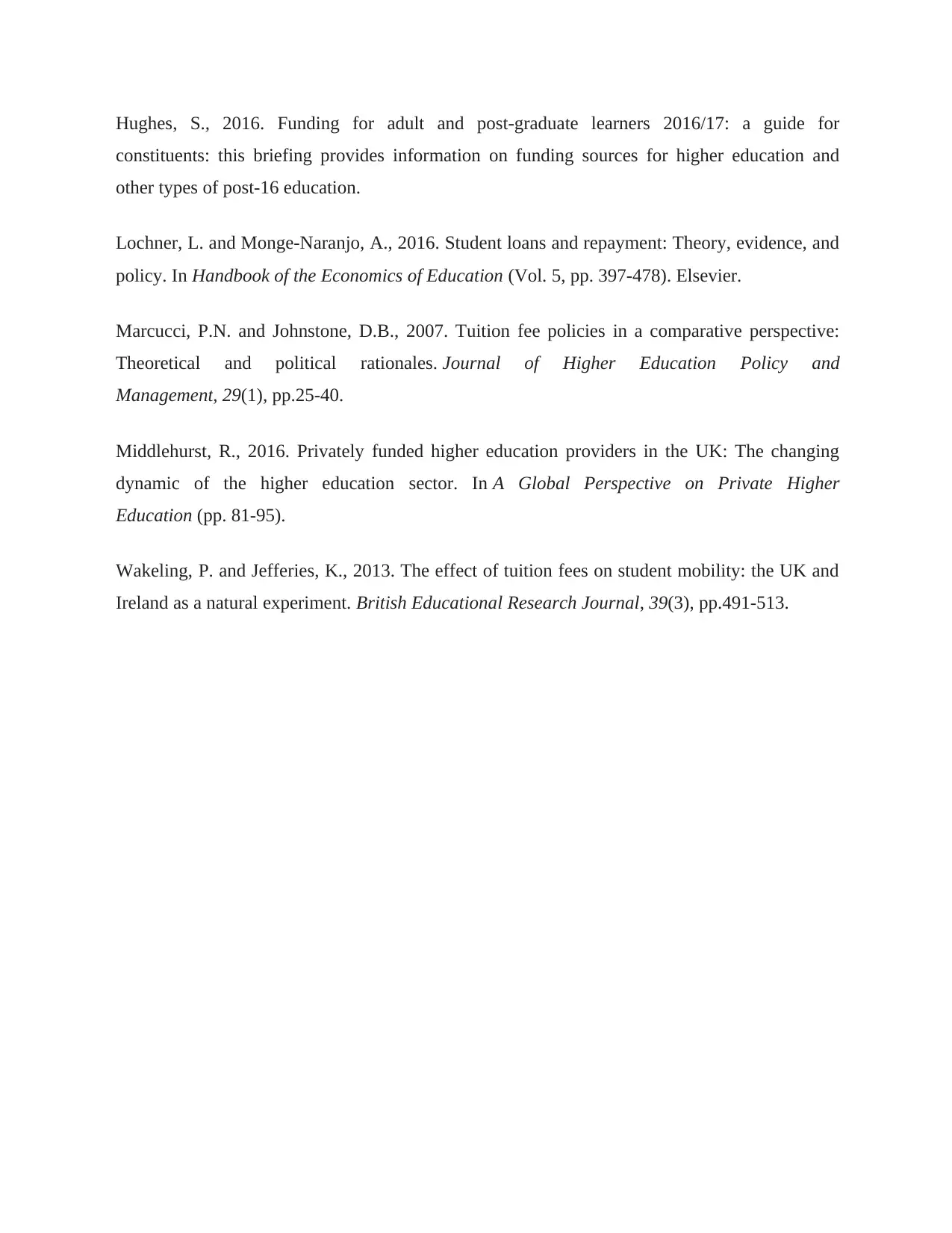
Hughes, S., 2016. Funding for adult and post-graduate learners 2016/17: a guide for
constituents: this briefing provides information on funding sources for higher education and
other types of post-16 education.
Lochner, L. and Monge-Naranjo, A., 2016. Student loans and repayment: Theory, evidence, and
policy. In Handbook of the Economics of Education (Vol. 5, pp. 397-478). Elsevier.
Marcucci, P.N. and Johnstone, D.B., 2007. Tuition fee policies in a comparative perspective:
Theoretical and political rationales. Journal of Higher Education Policy and
Management, 29(1), pp.25-40.
Middlehurst, R., 2016. Privately funded higher education providers in the UK: The changing
dynamic of the higher education sector. In A Global Perspective on Private Higher
Education (pp. 81-95).
Wakeling, P. and Jefferies, K., 2013. The effect of tuition fees on student mobility: the UK and
Ireland as a natural experiment. British Educational Research Journal, 39(3), pp.491-513.
constituents: this briefing provides information on funding sources for higher education and
other types of post-16 education.
Lochner, L. and Monge-Naranjo, A., 2016. Student loans and repayment: Theory, evidence, and
policy. In Handbook of the Economics of Education (Vol. 5, pp. 397-478). Elsevier.
Marcucci, P.N. and Johnstone, D.B., 2007. Tuition fee policies in a comparative perspective:
Theoretical and political rationales. Journal of Higher Education Policy and
Management, 29(1), pp.25-40.
Middlehurst, R., 2016. Privately funded higher education providers in the UK: The changing
dynamic of the higher education sector. In A Global Perspective on Private Higher
Education (pp. 81-95).
Wakeling, P. and Jefferies, K., 2013. The effect of tuition fees on student mobility: the UK and
Ireland as a natural experiment. British Educational Research Journal, 39(3), pp.491-513.
1 out of 7
Related Documents
Your All-in-One AI-Powered Toolkit for Academic Success.
+13062052269
info@desklib.com
Available 24*7 on WhatsApp / Email
![[object Object]](/_next/static/media/star-bottom.7253800d.svg)
Unlock your academic potential
Copyright © 2020–2025 A2Z Services. All Rights Reserved. Developed and managed by ZUCOL.




